Independent home inspection in Portugal — costs, common issues, and how to use your report to negotiate.
Everything expats need to know about home inspections in Portugal—costs, common issues, and how an independent inspection helps you buy safely and negotiate with confidence.


Thinking of buying a home in Portugal? A professional home inspection gives you clarity beyond attractive listing photos and bank valuations, helping you avoid costly surprises and negotiate effectively.
This comprehensive guide explains exactly what a home inspection covers, typical issues found in Portuguese properties, estimated costs, and how to leverage inspection findings during your home-buying process in Portugal.
Quick Facts (PIDS Home Inspection)
- Experts: Certified Portuguese civil engineers and architects with over 30 years of local experience.
- Inspection Type: Visual and non-invasive inspection of accessible areas.
- Report Delivery: Digital PDF within 48 hours of the inspection.
- Languages: English or Portuguese

Table of Contents
- Inspection vs. Bank Valuation
- What Does the Home Inspection Cover?
- Common Issues by Region and Property Age
- 15-Minute Viewing Checklist
- How to Use Inspection Findings in Negotiations
- Home Inspection Costs and Timelines
- Home Inspection Report
- Book Your Inspection
- FAQs for Expat Buyers
Inspection vs. Bank Valuation: What’s the Difference?
A bank valuation is not a home inspection.
- Bank Valuation: Estimates market value for mortgage purposes but does not perform a thorough check on the property condition.
- Home Inspection: An independent evaluation of the home’s actual physical state, safety, maintenance needs, and potential issues—essential for informed decisions, especially for expats buying remotely.
What Does the Home Inspection Cover?
Exterior and Grounds
- Site drainage and grading
- Driveways, paths, retaining walls
- Vegetation and trees affecting the property
- Rainwater and wastewater management
Structural Integrity
- Foundation condition
- Signs of structural movement (cracks on wall and ceilings)
- Roof covering, flashings, chimneys, gutters
- External walls (paint/render quality, insulation) and property thermal insulation
- Windows, doors, shutters, garage doors
Interior Elements
- Walls, floors, ceilings, finishes
- Fireplaces and chimneys
- Staircases and balustrades
- Moisture issues and insulation
- Kitchen and bathroom fixtures and ventilation
- Basement and garage moisture condition
Mechanical, Electrical & Plumbing (MEP)
- Electrical panels, wiring, earthing and bonding, lighting
- Plumbing systems, water pressure, heating, drainage
- Heating and cooling systems (HVAC)
Safety and Accessibility
- Smoke and carbon monoxide detectors
- Railings and balcony
- Fire exits and safety hazards
- Pool safety (where applicable)
Moisture and Environmental Conditions
- Indoor humidity levels
- Visual signs of mould, mildew, or wood-destroying organisms
Common Property Issues in Portugal by Region & Era
Coastal Algarve & Silver Coast (high humidity & salt air)
Homes near the Atlantic are exposed to constant moisture and salty winds. This often leads to façade cracking and paint deterioration, corrosion of metals like railings and hinges, condensation on single-glazed windows, and mould in closets or bathrooms. Flat roofs are especially vulnerable to ponding water and leaking membranes. Regular façade maintenance and improved ventilation are essential for comfort in these regions.
Lisbon & Porto (older apartments vs. newer builds)
Historic apartments built before the 1990s often suffer from outdated electrics, mixed plumbing materials, and poor insulation. Single-glazing and inadequate bathroom ventilation lead to condensation and higher heating costs. Even post-2000 builds can show defects such as air leakage around sliding windows, stress cracks in façade systems, or moisture intrusion in basements and garages. Buyers should budget for upgrades to meet modern safety and energy standards.
North & Interior Regions (Minho, Beiras, Serra da Estrela)
Traditional granite or stone houses frequently show signs of rising damp, visible as salt deposits and peeling plaster at the base of walls. Cold winters and intermittent heating make ventilation difficult, encouraging mould growth. Attics and older timber roofs are also prone to woodworm and decay if not treated. Expats buying here should factor in insulation improvements, lime-based plasters, and long-term damp management.
Alentejo & Inland Algarve (hot summers, wide temperature swings)
Homes in these regions often use traditional taipa (rammed earth) or stone walls, but many have been covered with hard cement renders that trap moisture and cause bulging or cracks. Shallow eaves expose façades to sun damage and rain, while west-facing windows can make interiors uncomfortably hot without shutters or shading. Restoration with breathable lime renders and solar protection measures is usually required.
Madeira & Azores (very high rainfall, storms)
Properties in the islands face unique challenges due to extreme rainfall and frequent storms. Roof membranes fatigue quickly, ridge tiles may lift in high winds, and poor tie-downs increase the risk of leaks. Metal fixings corrode rapidly if not stainless steel. High indoor humidity leads to mould behind furniture and in corners, requiring year-round ventilation or dehumidification strategies.
Rural Villas Nationwide
Detached villas often show site drainage problems, with rainwater running toward foundations and causing settlement of paths or driveways. Structural cracks around garage lintels and wide openings are common. Basements and garages frequently show damp patches in winter, and swimming pools may lack proper electrical bonding or show cracks in coping joints. Addressing these issues early prevents costly structural repairs.
Recently Renovated or New Builds (2010–2025)
Even newer properties are not immune to defects. Cosmetic renovations may hide old plumbing or electrical systems. Poor detailing—such as balcony upstands that are too low or flat roofs with insufficient slope—can lead to early water ingress. Thermal bridges around slab edges and box shutters cause heat loss despite added insulation. Snagging inspections before handover are crucial to catch these overlooked details.
15-Minute Viewing Checklist
When viewing properties, quickly check for these red flags:
- Rust streaks, bubbling paint, or hairline façade cracks?
- Musty odours in closets/bathrooms or condensation on windows?
- Water pooling on balconies or flat roofs?
- Ground sloping toward the property?
- Old electrical panels with mixed breakers or no labels?
- Single-glazed windows or corroded frames?
- Damp marks or salt deposits on ground-floor walls, basement or in garages?
How to Leverage Inspection Findings in Negotiations
Using your home inspection report effectively can significantly improve your buying experience:
- Schedule Early: Ideally, conduct your inspection before signing the CPCV (promissory contract) is common but not mandatory, used to lock terms before the deed. If timing is tight, request a clause allowing renegotiation or withdrawal based on the inspection findings.
- Prioritize Repairs: Focus negotiations on urgent repairs and critical safety issues identified in your report, such as structural problems, electrical hazards, damp and moisture, property insulation and ventilation, and roof defects.
- Negotiate with Confidence: Clearly document inspection findings with detailed excerpts and photos from your report. Provide cost estimates from professionals to justify requests for repairs or price adjustments.
- Plan Strategically: Distinguish between essential repairs and long-term improvements. Immediate concerns should form the basis of your negotiation, while minor issues can be addressed after purchase.
Your inspection report clearly outlines issues that commonly lead to successful negotiations, helping you secure the best possible terms for your new home.
Home Inspection Costs & Timelines
Typical Inspection Fees :
- Apartments (T1–T4): €450–€700
- Villas (T2–T4+): €550–€900+purchase.
Timelines:
- Booking: Minimum 48 hours in advance
- Duration: Apartments ~1–2 hours; Villas ~2–3 hours
- Report Delivery: 48 hours after inspection (Digital Inspection Report)
What Does a Home Inspection Report Include?
- Easy-to-understand summary with priority ratings: Critical / Fair / Good / Excellent, plus an overall summary of the property’s condition
- Specific recommendations for repairs or improvements
- Clear and detailed inspection report with minimum 30+ pages including photos
- Digital Inspection Report within 48 Hours
- 100+ Checkpoints
- Structural Condition (Foundation, Wall, Roof)
- Property Insulation Condition (Doors and Windows)
- Interior Condition (Floor, Wall, Ceiling)
- Electrical System
- Plumbing System
- Heating System (HVAC)
- Moisture, Mold, Ventilation Check
- Safety Check
- Recommendations
- Digital Report in Portuguese or English
- 24/7 Customer Support
Book Your Home Inspection
02
Confirmation of booking.
03
Actual property inspection on site.
04
Detailed inspection report in 48 hrs.
FAQs for Expat Home Buyers

When should I book the inspection?
- Ideally, before signing the CPCV.
What if I cannot attend the inspection?
- It’s completely fine if you can’t attend personally. Just ensure your agent or representative is present to grant access. Everything will be thoroughly documented in the final inspection report.
What preparation is needed?
- Ensure utilities (water/electricity) are active and keys provided.
Most common negotiation points?
- Roof leaks, structural cracks, electrical issues, HVAC issues, property insulation condition, moisture and ventilation problems.
Do banks accept third-party inspection reports in Portugal?
- No. Banks rely only on their own valuation reports for mortgage purposes. However, your independent inspection report gives you leverage for negotiations with the seller and ensures you’re aware of issues the bank valuation won’t cover.
What if the seller refuses repairs after the inspection?
- You can use the findings to renegotiate the purchase price or request a discount to cover repair costs. If the defects are serious and you have included an inspection clause in the CPCV, you may also walk away from the deal without penalty.
Do I need a snagging inspection for a new build?
- Yes. Even new builds often hide defects like poor balcony detailing, flat roof drainage issues, or thermal bridging. A snagging inspection before handover ensures the developer fixes problems while still under warranty.
How does humidity near the coast affect homes?
- High humidity and salt air cause accelerated corrosion of metal fixings, façade cracks, condensation on windows, and mould growth in closets or bathrooms. Coastal homes require more frequent maintenance, proper ventilation, and salt-resistant materials.